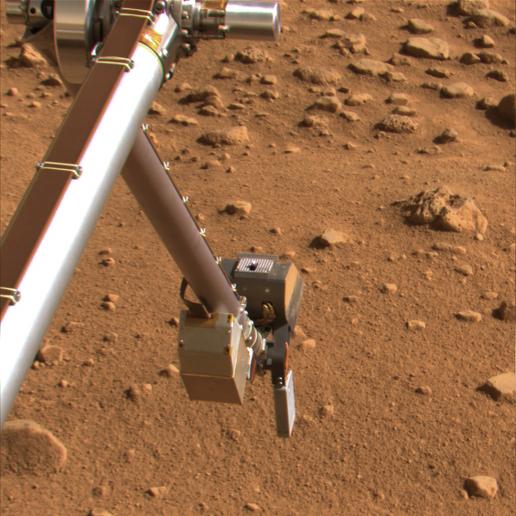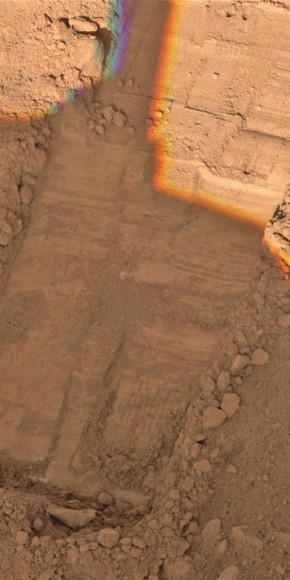The Phoenix Mars Lander successfully used a rasp on the end of its robotic arm to drill into the frozen soil on Mar’s arctic tundra. This effort loosened the icy material, which was then scraped up and collected in the lander’s scoop. Images and data sent from Phoenix early today indicated the shaved material in the scoop had changed slightly over time during the hours after it was collected, which is a sign that the material includes water ice. Water ice sublimates, or evaporates on Mars surface because of the low surface pressure on the Red Planet. It can exist just under the surface, however, protected by the soil.
The motorized rasp — located on the back of the lander’s robotic arm scoop — made two distinct holes in a trench informally named “Snow White.” The material loosened by the rasp was collected in the scoop and documented by the Robotic Arm Camera. The activity was a test of the rasping method of gathering an icy sample, in preparation for using that method in coming days to collect a sample for analysis in an oven of Phoenix’s Thermal and Evolved-Gas Analyzer (TEGA).
“This was a trial that went really well,” said Richard Morris, a Phoenix science team member from NASA’s Johnson Space Center, Houston. “While the putative ice sublimed out of the shavings over several hours, this shows us there will be a good chance ice will remain in a sample for delivery” to Phoenix’s laboratory ovens.

The motorized rasp bit extends from the back of the scoop on the end of Phoenix’s 2.35-meter-long (7.7-foot-long) robotic arm. The tool works just a rasp for woodworking, which coarsely files or shaves material.
‘While Phoenix was in development, we added the rasp to the robotic arm design specifically to grind into very hard surface ice,’ said Barry Goldstein, Phoenix project manager at NASA’s Jet Propulsion Laboratory, Pasadena, Calif. ‘This is the exactly the situation we find we are facing on Mars, so we believe we have the right tool for the job. Honeybee Robotics in New York City did a heroic job of designing and delivering the rasp on a very short schedule.'”
The past few days, Phoenix used its robotic arm to clear the top layer of dirt from a trench it dug called Snow White. On Tuesday, Phoenix used the rasp to dig into two spots at the bottom of the trench.
Mission scientists have been working on techniques to quickly obtain the sample and then deliver it to the TEGA before too much ice has sublimated away. The TEGA test will “bake” the soil, releaseing gases present to help sciencists learn more about the ice’s composition.
Today, (Wednesday) Phoenix will be commanded to continue scraping and enlarging the “Snow White” trench and to conduct another series of rasp tests. The lander’s cameras will again be used to monitor the sample in the scoop after its collection.
Original News Source: Phoenix Press Release


colour photos!! love it!!